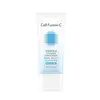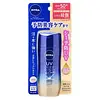What's inside
What's inside
 Key Ingredients
Key Ingredients

 Benefits
Benefits

 Concerns
Concerns

 Ingredients Side-by-side
Ingredients Side-by-side

Water
Skin ConditioningDibutyl Adipate
EmollientAlcohol Denat.
AntimicrobialButyloctyl Salicylate
Skin ConditioningSilica
AbrasiveDipropylene Glycol
HumectantEthylhexyl Triazone
UV AbsorberBis-Ethylhexyloxyphenol Methoxyphenyl Triazine
Skin ConditioningOctocrylene
UV AbsorberPropanediol
SolventNiacinamide
SmoothingErythritol
HumectantTerephthalylidene Dicamphor Sulfonic Acid
UV AbsorberPentylene Glycol
Skin ConditioningMethylpropanediol
SolventTromethamine
BufferingSphingomonas Ferment Extract
Skin ConditioningSaccharomyces Ferment Filtrate
HumectantRosmarinus Officinalis Leaf Water
MaskingCentella Asiatica Extract
CleansingTremella Fuciformis Extract
HumectantCamellia Sinensis Leaf Extract
AntimicrobialMentha Rotundifolia Leaf Extract
TonicThymus Vulgaris Leaf Extract
Skin ProtectingSodium Hyaluronate
HumectantPolymethylsilsesquioxane
1,2-Hexanediol
Skin ConditioningButylene Glycol
HumectantHydroxyethyl Urea
HumectantPolyglyceryl-3 Methylglucose Distearate
EmulsifyingStearyl Heptanoate
EmollientDimethiconol
EmollientPoly C10-30 Alkyl Acrylate
Emulsion StabilisingMicrocrystalline Cellulose
AbsorbentPolyether-1
Ethylhexylglycerin
Skin ConditioningAdenosine
Skin ConditioningSodium Stearoyl Glutamate
CleansingMethyl Diisopropyl Propionamide
MaskingCellulose Gum
Emulsion StabilisingAlbatrellus Confluens Extract
HumectantTocopherol
AntioxidantGlycerin
HumectantSodium Chloride
MaskingSodium Bicarbonate
AbrasiveCalcium Chloride
AstringentPotassium Chloride
Glycine
BufferingArginine
MaskingGlutamic Acid
HumectantBehenyl Alcohol
EmollientCarbomer
Emulsion StabilisingParfum
MaskingWater, Dibutyl Adipate, Alcohol Denat., Butyloctyl Salicylate, Silica, Dipropylene Glycol, Ethylhexyl Triazone, Bis-Ethylhexyloxyphenol Methoxyphenyl Triazine, Octocrylene, Propanediol, Niacinamide, Erythritol, Terephthalylidene Dicamphor Sulfonic Acid, Pentylene Glycol, Methylpropanediol, Tromethamine, Sphingomonas Ferment Extract, Saccharomyces Ferment Filtrate, Rosmarinus Officinalis Leaf Water, Centella Asiatica Extract, Tremella Fuciformis Extract, Camellia Sinensis Leaf Extract, Mentha Rotundifolia Leaf Extract, Thymus Vulgaris Leaf Extract, Sodium Hyaluronate, Polymethylsilsesquioxane, 1,2-Hexanediol, Butylene Glycol, Hydroxyethyl Urea, Polyglyceryl-3 Methylglucose Distearate, Stearyl Heptanoate, Dimethiconol, Poly C10-30 Alkyl Acrylate, Microcrystalline Cellulose, Polyether-1, Ethylhexylglycerin, Adenosine, Sodium Stearoyl Glutamate, Methyl Diisopropyl Propionamide, Cellulose Gum, Albatrellus Confluens Extract, Tocopherol, Glycerin, Sodium Chloride, Sodium Bicarbonate, Calcium Chloride, Potassium Chloride, Glycine, Arginine, Glutamic Acid, Behenyl Alcohol, Carbomer, Parfum
Water
Skin ConditioningAlcohol Denat.
AntimicrobialEthylhexyl Methoxycinnamate
UV AbsorberButylene Glycol
HumectantCaprylyl Methicone
Skin ConditioningDiethylamino Hydroxybenzoyl Hexyl Benzoate
UV FilterIsopropyl Palmitate
EmollientBis-Ethylhexyloxyphenol Methoxyphenyl Triazine
Skin ConditioningDiisopropyl Sebacate
EmollientEthylhexyl Triazone
UV AbsorberPolysilicone-15
UV FilterSilica Dimethyl Silylate
EmollientCitrullus Lanatus Fruit Extract
Skin ConditioningHydrolyzed Conchiolin Protein
Skin ConditioningRosa Damascena Flower Water
MaskingSodium Hyaluronate
HumectantPyrus Cydonia Fruit Extract
Skin ConditioningPolymethylsilsesquioxane
Acrylates/C10-30 Alkyl Acrylate Crosspolymer
Emulsion StabilisingLauroyl Lysine
Skin ConditioningHydroxypropyl Methylcellulose Stearoxy Ether
Sodium Dilauramidoglutamide Lysine
HumectantC30-45 Alkyl Methicone
EmollientC30-45 Olefin
Skin ConditioningMenthoxypropanediol
MaskingPhenoxyethanol
PreservativeSodium Hydroxide
BufferingBHT
AntioxidantMethylparaben
PreservativeParfum
MaskingWater, Alcohol Denat., Ethylhexyl Methoxycinnamate, Butylene Glycol, Caprylyl Methicone, Diethylamino Hydroxybenzoyl Hexyl Benzoate, Isopropyl Palmitate, Bis-Ethylhexyloxyphenol Methoxyphenyl Triazine, Diisopropyl Sebacate, Ethylhexyl Triazone, Polysilicone-15, Silica Dimethyl Silylate, Citrullus Lanatus Fruit Extract, Hydrolyzed Conchiolin Protein, Rosa Damascena Flower Water, Sodium Hyaluronate, Pyrus Cydonia Fruit Extract, Polymethylsilsesquioxane, Acrylates/C10-30 Alkyl Acrylate Crosspolymer, Lauroyl Lysine, Hydroxypropyl Methylcellulose Stearoxy Ether, Sodium Dilauramidoglutamide Lysine, C30-45 Alkyl Methicone, C30-45 Olefin, Menthoxypropanediol, Phenoxyethanol, Sodium Hydroxide, BHT, Methylparaben, Parfum
 Reviews
Reviews

Ingredients Explained
These ingredients are found in both products.
Ingredients higher up in an ingredient list are typically present in a larger amount.
Alcohol Denat. is an alcohol with a denaturant property. It is created by mixing ethanol with other additives.
This ingredient gets a bad rep because it is irritating and drying - mostly due to its astringent property. Astringents draw out natural oils in tissue, constricting pores and leaving your skin dried out.
However, alcohol denat. is not all that bad.
Due to its low molecular weight, alcohol denat. tends to evaporate quickly. One study on pig skin found half of applied alcohol evaporated in 10 seconds and less than 3% stayed on skin.
This also helps other ingredients become better absorbed upon application.
Studies are conflicted about whether this ingredient causes skin dehydration. One study from 2005 found adding emollients to propanol-based sanitizer decreased skin dryness and irritation. Another study found irritation only occurs if your skin is already damaged.
Small amounts of alcohol are generally tolerated by oily skin or people who live in humid environments.
The rule of thumb is if this alcohol is near the end of an ingredients list, it will probably not affect your skin much.
Also...
This ingredient has antimicrobial and solvent properties.
The antimicrobial property helps preserve products and increase their shelf life. As a solvent, it helps dissolve other ingredients.
Other types of astringent alcohols include:
Learn more about Alcohol Denat.You might know this ingredient as Tinosorb S or Bemotrizinol. It is a UV filter that covers both UVA and UVB rays.
This ingredient has two peak UV absorption peaks ( 310 and 340 nm) and is able to absorb both UV-A and UV-B rays. This ingredient works by preventing UV rays from reaching and damaging your skin.
On top of that - it is highly photostable and helps prevent the photodegration of other sunscreen ingredients such as avobenzone.
Tinosorb S is allowed in the EU, Australia, and Asia. It is close to being approved by the FDA and we'll hopefully get this ingredient in the U.S. by late 2025.
Fun fact: Tinosorb S is the most effective UV absorber at maximum concentration (measured by SPF) permitted in the EU.
This ingredient is oil-soluble, so your oil-cleansers will take this right off at night.
Learn more about Bis-Ethylhexyloxyphenol Methoxyphenyl TriazineButylene Glycol (or BG) is used within cosmetic products for a few different reasons:
Overall, Butylene Glycol is a safe and well-rounded ingredient that works well with other ingredients.
Though this ingredient works well with most skin types, some people with sensitive skin may experience a reaction such as allergic rashes, closed comedones, or itchiness.
Learn more about Butylene GlycolEthylhexyl Triazone is a modern chemical sunscreen that protects from UV-B radiation.
It is the most effective of existing UV-B filters, as it provides the highest level of photo-stable absorption. It protects from the entire UV-B range (280 to 320nm), with it's highest level of protection at 314nm.
Ethylhexyl Triazone is oil soluble, oderless and colorless, which mean it is able to be incorporated into a variety of different formulations.
It is not currently available within the United States due to slow changing FDA regulations. Outside of the US, it is used in formulations at concentrations up to 5%.
Learn more about Ethylhexyl TriazoneParfum is a catch-all term for an ingredient or more that is used to give a scent to products.
Also called "fragrance", this ingredient can be a blend of hundreds of chemicals or plant oils. This means every product with "fragrance" or "parfum" in the ingredients list is a different mixture.
For instance, Habanolide is a proprietary trade name for a specific aroma chemical. When used as a fragrance ingredient in cosmetics, most aroma chemicals fall under the broad labeling category of “FRAGRANCE” or “PARFUM” according to EU and US regulations.
The term 'parfum' or 'fragrance' is not regulated in many countries. In many cases, it is up to the brand to define this term.
For instance, many brands choose to label themselves as "fragrance-free" because they are not using synthetic fragrances. However, their products may still contain ingredients such as essential oils that are considered a fragrance by INCI standards.
One example is Calendula flower extract. Calendula is an essential oil that still imparts a scent or 'fragrance'.
Depending on the blend, the ingredients in the mixture can cause allergies and sensitivities on the skin. Some ingredients that are known EU allergens include linalool and citronellol.
Parfum can also be used to mask or cover an unpleasant scent.
The bottom line is: not all fragrances/parfum/ingredients are created equally. If you are worried about fragrances, we recommend taking a closer look at an ingredient. And of course, we always recommend speaking with a professional.
Learn more about ParfumPolymethylsilsesquioxane is a silicone used as a film forming agent.
When applied to the skin, this ingredient creates an invisible film on the surface. This film still allows oxygen to pass through, but prevents moisture from escaping. This can help condition and hydrate the skin. It also leaves a silky feel when applied.
Polymethylsilsesquioxane has not been shown to clog pores. It has been deemed safe to use up to 55%, but most cosmetics use much less.
If you have concerns about using this ingredient, we recommend speaking with a professional.
Learn more about PolymethylsilsesquioxaneSodium Hyaluronate is hyaluronic acid's salt form. It is commonly derived from the sodium salt of hyaluronic acid.
Like hyaluronic acid, it is great at holding water and acts as a humectant. This makes it a great skin hydrating ingredient.
Sodium Hyaluronate is naturally occurring in our bodies and is mostly found in eye fluid and joints.
These are some other common types of Hyaluronic Acid:
Learn more about Sodium HyaluronateWater. It's the most common cosmetic ingredient of all. You'll usually see it at the top of ingredient lists, meaning that it makes up the largest part of the product.
So why is it so popular? Water most often acts as a solvent - this means that it helps dissolve other ingredients into the formulation.
You'll also recognize water as that liquid we all need to stay alive. If you see this, drink a glass of water. Stay hydrated!
Learn more about Water